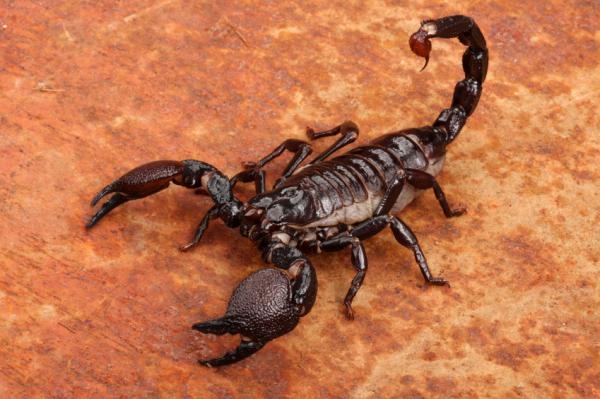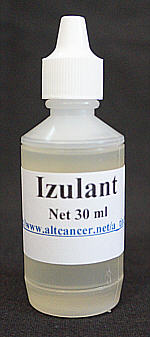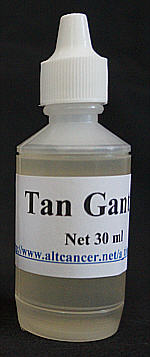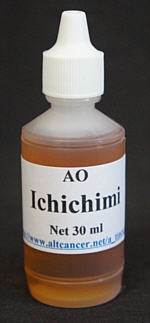
 Summarized Description:
Summarized Description:
The therapeutic use of poisonous venom from animal life forms as diverse as
cobra snakes
to
'deathstalker' scorpions
is well-established. The former is even providing evidence of strong
anti-tumor properties.

For the peoples of the Peruvian Amazon, none
of these preparations are as common or as in frequent use as the "ant tinctures,"
primarily employed for topical pain relief and anti-inflammation, and to treat
arthritic and muscle pain problems.
WARNING: These tinctures are intended
for topical application only -- not internal use. Keep out of reach of children!
NOTE: As you'll see in the instructions below, you only use anywhere from two to
ten drops for an application. Each product is one fluid ounce (about 30 ml.), which
contains approximately 600 drops.
 Alpha Omega Labs
Alpha Omega Labs is proud to introduce
three of the most commonly used pain-relief tinctures used by the shamans,
herbalists, and
curenderos of the Peruvian Amazon :


The
Izula ant
(Paraponera clavata), as it is referred to in the Peruvian Amazon, stings with a potency so great, it is said to be one
of the most painful on earth. Out of this observation comes this insect's nickname, "bullet ant," because the pain of one sting
from one ant can rival that of a bullet wound. ( 1 )

The tincture made from this ant is a powerful topical pain-killer, which works
by blocking the nerve transmission of pain signals. There are several chemical compounds which work together to reduce
pain, of which
Poneratoxin is but one. ( 2 ) This one
chemical has been shown to
block synaptic transmission and
depolarize interneurons, as well as
block sodium channels
in the nerves. Of the three tinctures in this group,
Izulant (tm) is the strongest
in terms of topical pain relief.

The first reported use of Izula ant venom was to treat rheumatoid arthritis.
In addition to pain relief and reducing inflammation / swelling, it may also improve immune and liver functions. ( 3 )
 Instructions for Use:
Instructions for Use: Puncture the top of the bottle with a large needle,
then apply anywhere from 2 to 10 drops over the area where pain is experienced. If using this product together with
Cansema, you may use the product at any
stage
of the escharotic process. If applying to the site of an eschar or other puscular formation, be sure to cover liberally the
peripheral area around the scab itself. It takes about 40 minutes before pain relief commences, and it normally lasts for
several hours.


The
Tangarana ant
(Pseudomyrmex triplarinus) gets its name from the Tangarana, a member of the
Triplaris
genus of trees, primarily
Triplaris americana, a natural
"myrmecophyte," which forms a symbiotic, mutualistic relationship with the ants.

The indigenous of the Peruvian Amazon use the ant venom to treat rheumatoid arthritis.
Traditionally, the afflicted person would go to the tree, disturb the ants, and intentionally allow their hands to be bitten.
However, a concentrated tincture can be prepared which has a similar effect without the need to be bitten. The effect is analgesic
and anti-inflammatory, and although the former property is generally not as strong as
Izulant (tm) --
(above) --
it is generally longer lasting. The
anti-inflammatory property is thought to derive chiefly from "myrmexins," with six isoforms of venom proteins. ( 4 )

The response from the orthodox community has been guarded, as is the case
with any medicinal material that doesn't come with a proprietary monopoly, but even then the results can only be
downplayed so much: "Interestingly enough, the species of
Pseudomyrmex triplarinus has a
venom that has been analyzed and it seems as though it has some qualities
which can be used in the treatment of rheumatoid arthritis (Ward 2002).
Its venom has anti-inflammatory properties (Pan and Hink 2000)
and analgesic agents useful in treating autoimmune diseases,
especially rheumatoid arthritis (Sukhwani). The venom . . . analysis shows
that it has high contents of glycoprotein, heparin, chondroitin sulphate,
polysaccharides and other hydrocarbons. It has high activity when it is highly purified,
with very few adverse effects, allowing for long-lasting results. ( 5 )
 Instructions for Use:
Instructions for Use: Puncture the top of the bottle with a large needle,
then apply anywhere from 2 to 10 drops over the area where pain is experienced. If using this product together with
Cansema, you may use the product at any
stage
of the escharotic process. If applying to the site of an eschar or other puscular formation, be sure to cover liberally the
peripheral area around the scab itself. It takes about 40 minutes before pain relief commences, and pain relief lasts for
an average of twelve (12) hours.


The
Ichichimi Rojo ant
(Dolichoderus germaini) is the least researched of the venomous ants in this series. Far less painful than Izula, the bite of
Ichichimi Rojo has more of a numbing effect -- and similar to Tangarana, it is used for its pain relieving and anti-inflammatory effects.
 Instructions for Use:
Instructions for Use: Puncture the top of the bottle with a large needle,
then apply anywhere from 2 to 10 drops over the area where pain is experienced. If using this product together with
Cansema, you may use the product at any
stage
of the escharotic process. If applying to the site of an eschar or other puscular formation, be sure to cover liberally the
peripheral area around the scab itself. It takes about 40 minutes before pain relief commences, and it normally lasts for
several hours.
Shelf-Life

Five years or more.
Footnotes
- Also from :
http://en.wikipedia.org/wiki/Paraponera_clavata
- See : http://www.ncbi.nlm.nih.gov/pubmed/1685425?dopt=Abstract
- "Molecular Pharmacology and Toxinology of Venom from Ants"
http://cdn.intechopen.com/pdfs/45137/
InTechMolecular_pharmacology_and_toxinology_of_venom_from_ants.pdf
- See : http://www.ncbi.nlm.nih.gov/pubmed/10758275
- See : http://saraguitiprado.wordpress.com/ant-page/pseudomyrmex-triplarinus/